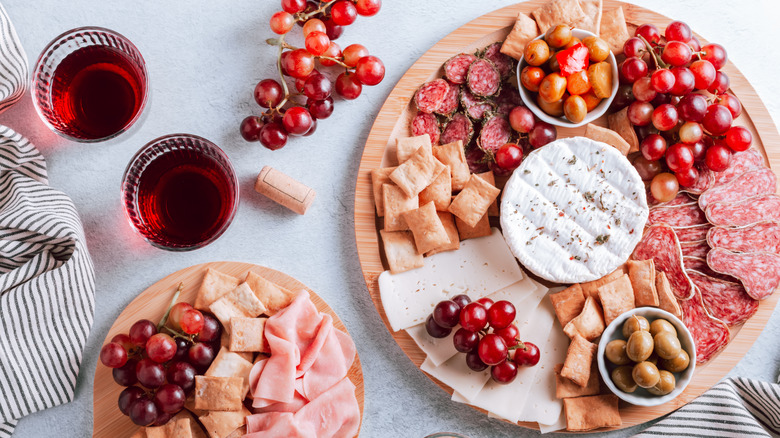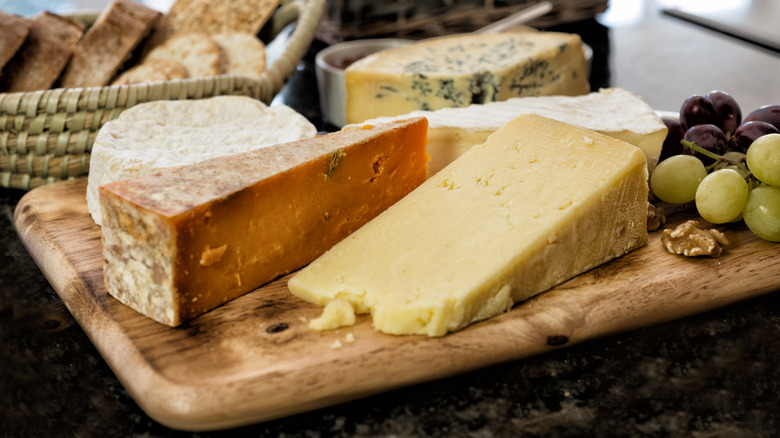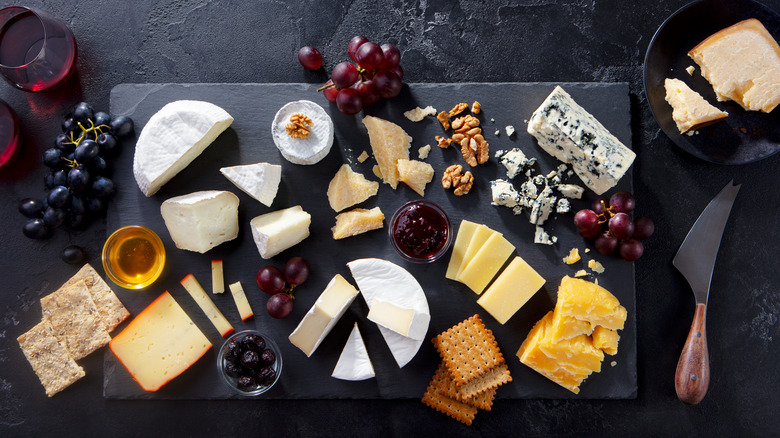Why You Shouldn't Serve Your Guests Cheese On A Wooden Board
When it comes to cheese boards, most people are accustomed to their aged Gruyeres and English Stiltons arriving on a flat, wooden board, hence the term "cheese board." Wooden boards are sturdy, come in a variety of sizes, and make a smashing presentation. Who would have thought that displaying your favorite cheeses on such a item really isn't the best idea?
The problem is that wood is porous, which means it can and does absorb flavors and odors very easily. Even after the board is washed and dried it can harbor residual aromas that might not be so pleasant. While it's easy to appreciate a good cheese funk while in the cheese-eating moment, most people would agree that too much of it just plain stinks. Fortunately, there are other materials and boards out there that make better options, and they can look just as attractive as the vintage wood board you love to display.
Knock on wood
The porous, odorous situation is two-fold when it comes to wooden cheese boards. First, if you use that board to chop garlic or onions, those smells and odors remain prominent and can affect the way your cheese tastes. You're familiar with this phenomenon if you've ever chopped an apple on a wooden board and your apple takes on the nasty essence of Vidalia onion. The same thing can happen to your cheese. Similarly, the board will cling to the stronger cheese flavors and impart their flavors onto whatever you chop next.
Sure, you could designate a single wooden board just for cheeses, but new cheeses could still pick up the odors of whatever cheese was last placed there. If you don't mind this, that's cool, but when it comes to guests, you certainly don't want to unintentionally turn them off due to off-putting smells and tastes.
It's certainly worth noting that there are certain types of wood that are non-porous and/or harder than others, including teak, cherry, maple, and walnut. If you insist upon a wooden cheese board, seek out one of these to decrease the odor-absorbing possibilities.
Not so boring boards
With the popularity of cheese boards skyrocketing, it's no surprise that cheese board materials have also increased substantially. While wood is arguably the most popular choice, it's definitely not the only option. Other boards, in fact, are superior because they don't absorb odors, they are easy to clean, and they are beautiful to behold. Slate is one such option. Cheeses visually pop on the dark color of slate cheese boards, and many of them come with chalk so you can label your cheeses right on the slate itself.
Although they are not the best cutting boards to use for food prep, boards made of glass are a sturdy option for cheeses, plus you can typically put them right in the dishwasher for easy cleanup. Resin boards and marble slabs also work well for displaying cheese. If wood is all you've got (porous or otherwise), consider placing your cheeses on top of cheese paper or untreated fruit leaves like fig or lemon (they need to be untreated as you don't want to use anything that's been sprayed with chemicals or pesticides). Placing a thin layer between the board and the cheese should help in the odor absorption factor, plus it looks rustic and classy.



